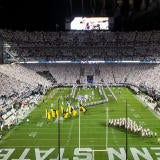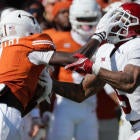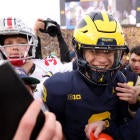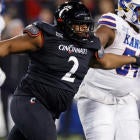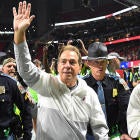The adoption of an early signing period has quietly become one of the most significant moments in recent college football history.
“If it goes through,” Big 12 commissioner Bob Bowlsby said, “it will be the most impactful piece of football recruiting legislation in 25 years.”
That contentious early signing period is part of a bundled package of wide-ranging changes to the game that will be taken up either Thursday or Friday by the NCAA Council in Indianapolis.
The intent is to keep college football from becoming the recruiting backwater college basketball has devolved into. It relieves pressure on recruits, lessens third-party influence and curbs excess.
If, that is, it all passes. The early signing period is the centerpiece. For years -- perhaps decades -- there has been little consensus on that early period, which essentially relieves the pressure on recruits.
That first Wednesday in February known as National Signing Day has become a bloated -- sometimes shady -- talent rodeo. You’ve seen some of the excess, such as live animal stage shows and recruiting tactics that tend to damage both the coach and recruit.
“This is as convoluted a situation as I’ve seen in 34 years of collegiate coaching,” said Todd Berry, executive director of the American Football Coaches Association. “From a student-athlete perspective and a coaches’ perspective, we’re in a bad place right now in terms of this whole recruiting model.”
But finally, most everyone who matters seems to be on board at least for a mid-December early signing date that would coincide with the junior college period. Proposal No. 2016-116 took years to craft; experts warn it could be picked apart.
The bundled package resembles a Congressional bill with typical partisan elements built in. Within the legislation is a proposal for a 10th full-time assistant coach. Was that enough to get the coaches to support an early signing period?
Any attempt to undo the bundle and make the proposals ala carte could mean failure.
“There are people who like some parts of it, not all parts of it,” Bowlsby said of the overall proposals. “So there is a fair amount of horse trading to be done.”
Bowlsby is chairman of the Football Oversight Committee that helped craft the legislation. Here is Jon Solomon’s critique of the bundle from October.
Proponents say adding a second signing period in December would relieve the pressure of the whole process being funneled into that February date. Scores of coaches agree that many -- if not most -- recruits have their minds made up by that point.
Why leave them languish for 1 ½ months when they can be picked off by rival schools?
One source said this entire bundle -- if it doesn’t pass mostly as-is -- calls into question the NCAA governance system. Almost 2 ½ years ago, the Power Five were given autonomy on larger issues like this.
“The feeling was, in order to get something meaningful, you need to do a package,” Berry said. “The minute you take something out and [make] amendments, you see it falling apart.”
The Power Five conferences have the leverage, if they choose to vote as a bloc. The votes of the Big Ten, ACC, Big 12, Pac-12 and SEC count for two each. The Group of Five (Sun Belt, Conference USA, Mid-American, American, Mountain West) and FCS conferences each count for one.
Digging down on the issues:
Do the conferences want to significantly limit the influence of so-called IAWP (individuals associated with a prospect)? Those third-party folks have wedged their way past high school coaches in many cases in terms of influence of prospects. The legislation would make a prospect ineligible whose IAWP is hired in a non-coaching role two years before his enrollment and two years after eligibility is expired.
Do they want to adopt what amounts to a Harbaugh Rule? The Michigan coach’s exploitation of the camp rule was fun to cover, but many thought Satellite Camps Over America was just over the top. The new legislation would limit camps to a 10-day period in June.
Do they want to give recruits the luxury of official visits basically in a three-month period (April-June) of their junior year? If that recruiting calendar changes, the early signing period would then have to be approved by the Collegiate Commissioner Association (CCA) at their annual meeting in June.
Do they want to get serious about changing coaches’ chronically bad habit of oversigning? “Because the camp environment is a mess and has been for a long time, we haven’t been able to get enough support to fix it,” Bowlsby said. “Oversigning has been a controversial component for many years. We haven’t been able to get enough votes to fix it. The early singing date, we’ve never been able to get anything close to a simple majority to pass that. It feels like we’re pretty close on this one.”
If major-college football chooses to adopt all these measures, one high-profile recruiting expert called it “revolutionary.”
If not, one high-ranked source in the process speculated the NCAA Board of Governors may take over reform themselves. No one wants that.
“If it falls apart, watch out,” that source said.
Graduate transfer taboo
Louisville’s Bobby Petrino made news last week, blocking grad transfer Shaq Wiggins from a list of five schools.
That’s not so much a Petrino thing, as a college football thing. How does any coach still have the power to block a player who has graduated? Unless it’s not about obtaining a degree first, which they keep telling us, transfer blocking is outrageous.
Some even suggested such an act is the equivalent of a de facto non-compete clause. It certainly reinforces the assertion that athletes are employees. In these cases, the player has fulfilled his duty by graduating. Since 2006, graduates with eligibility remaining have been allowed to transfer without penalty.
@dennisdoddcbs Imagine that. This is a non-compete clause
— B. David Ridpath (@drridpath) April 8, 2017
Now, someone has to say it: “No coach should have anything to say about where kids transfer whether it’s undergrad transfer or grad transfer,” Bowlsby said.
Especially when coaches, athletic directors and presidents can “transfer” any time they want.
FCS powerhouse
It has been speculated that in the middle of the current basketball realignment, the FCS equivalent of a Power Five league could emerge. The basketball-only Summit League has four basketball members that have a split football membership in the Missouri Valley -- Western Illinois, South Dakota State, South Dakota and North Dakota State.
Both the Summit (membership here) and the Valley (basketball membership) are likely to be impacted in basketball realignment with Wichita State’s move to the American. But the Valley is one of the best FCS conferences in the country. Valley football member North Dakota State has won five FCS national titles since 2011.
What’s to keep the Summit from deciding to sponsor football and the raid the Valley to become more well-rounded? Same for the Valley which could take the three Dakota schools from the Summit (North Dakota State, South Dakota, South Dakota State) and expand to 12 in hoops?

